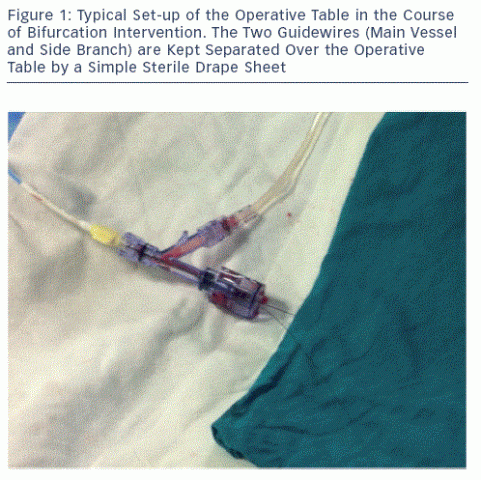Approaching the Bifurcation - Branch Wiring and Lesion Preparation
The provisional SB stenting approach is an A technique (A for across the SB) of the Main, Across, Distal, Side (MADS) classification5 adopted by the European Bifurcation Club (EBC) in 2007. A 6 French size (Fr) guide catheter is generally appropriate and this increases the overall safety of the procedure  since the radial approach may liberally be practised and large sheaths may not be needed. As a first step in a bifurcation PCI, it is usually advisable to wire both branches, MV and SB, with two 0.014 coronary guidewires.
since the radial approach may liberally be practised and large sheaths may not be needed. As a first step in a bifurcation PCI, it is usually advisable to wire both branches, MV and SB, with two 0.014 coronary guidewires.
Details regarding the wiring techniques for complex bifurcated lesions have been recently summarised by our group.6 According to our experience, the practice of wiring the more complex branch first and keeping the two wires separated over the operative table by a simple sterile drape sheet minimises the risk of wire twisting (see Figure 1). After wiring, the MV is pre-dilated if required (according to operators preference or after the direct stenting failure).
Regarding the SB preparation, there is a general consensus that SB dilation before MV stenting should be avoided in most of the cases since balloon dilation may cause SB dissections, which may cause an obstacle during subsequent rewiring. However, this concept has been recently challenged by the results of a randomised trial by Pan and colleagues7 showing improved result after MV stenting in patients with SB ostial disease randomised to SB pre-dilation versus no pre-dilation.
Thus, in case of true bifurcations with critical stenosis of a relevant SB, preventive SB dilation should probably be considered (with liberal use of non-compliant balloons). Some authors may recommend the use of scoring balloons or debulking devices in the case of (fibro)calcific SB ostial disease.